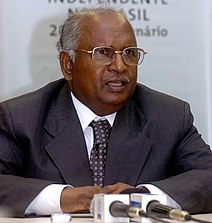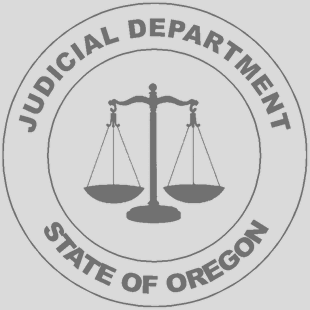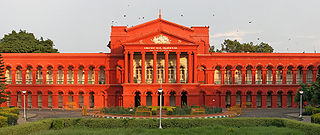The Government of Colombia is a republic with separation of powers into executive, judicial and legislative branches. Its legislature has a congress, its judiciary has a supreme court, and its executive branch has a president.

A justice of the peace (JP) is a judicial officer of a lower or puisne court, elected or appointed by means of a commission to keep the peace. In past centuries the term commissioner of the peace was often used with the same meaning. Depending on the jurisdiction, such justices dispense summary justice or merely deal with local administrative applications in common law jurisdictions. Justices of the peace are appointed or elected from the citizens of the jurisdiction in which they serve, and are usually not required to have any formal legal education in order to qualify for the office. Some jurisdictions have varying forms of training for JPs.

The term magistrate is used in a variety of systems of governments and laws to refer to a civilian officer who administers the law. In ancient Rome, a magistratus was one of the highest ranking government officers, and possessed both judicial and executive powers. In other parts of the world, such as China, a magistrate was responsible for administration over a particular geographic area. Today, in some jurisdictions, a magistrate is a judicial officer who hears cases in a lower court, and typically deals with more minor or preliminary matters. In other jurisdictions, magistrates may be volunteers without formal legal training who perform a judicial role with regard to minor matters.

The Government of India, often abbreviated as GoI, is the union government created by the constitution of India as the legislative, executive and judicial authority of the union of 29 states and seven union territories of a constitutionally democratic republic. It is located in New Delhi, the capital of India.

The Government of Queensland, also referred to as the Queensland Government, is the Australian state democratic administrative authority of Queensland. The Government of Queensland, a parliamentary constitutional monarchy, was formed in 1859 as prescribed in its Constitution, as amended from time to time. Since the Federation of Australia in 1901, Queensland has been a state of the Commonwealth of Australia, and the Constitution of Australia regulates its relationship with the Commonwealth. Under the Australian Constitution, Queensland ceded legislative and judicial supremacy to the Commonwealth, but retained powers in all matters not in conflict with the Commonwealth. Key state government offices are located at 1 William Street in the Brisbane central business district.

A district magistrate, often abbreviated to DM, is an Indian Administrative Service (IAS) officer who is the senior most executive magistrate and chief in charge of general administration of a district in India. Since district magistrates are responsible for collection of land revenue in the district, the post is also referred to as the district collector, and as the office-bearer works under the supervision of a divisional commissioner, the post is also known as deputy commissioner.
A Sub-Divisional Magistrate is a title which is sometimes given to the head official of a district subdivision, an administrative officer that is sometimes below the level of district, depending on a country's government structure. SDM is generally an officer of PCS ranking. Each district is divided into tehsil. It is empowered by tax inspector, Collector magistrate. All subdivisions (tehsils) are under the charge of SDM.
The District Courts of India are the district courts of the State governments in India for every district or for one or more districts together taking into account the number of cases, population distribution in the district. They administer justice in India at a district level.

Konakuppakatil Gopinathan Balakrishnan was the former Chairperson of the National Human Rights Commission of India. He is a former Chief Justice of India.

Uthamapalayam is a town and a taluka headquarters in Theni district in the Indian state of Tamil Nadu.
In India, Pakistan and Bangladesh, a tehsildar is a tax Officer accompanied with Revenue inspectors. They are in charge of obtaining taxes from a tehsil with regard to Land Revenue. A Tahsildar also known as Executive Magistrate of the tehsil concerned. The term is assumed to be of Mughal origin, and is perhaps a mental of the words "tehsil" and "dar".

Israeli law is based mostly on a common law legal system, though it also reflects the diverse history of the territory of the State of Israel throughout the last hundred years, as well as the legal systems of its major religious communities. The Israeli legal system is based on common law, which also incorporates facets of civil law. The Israeli Declaration of Independence asserted that a formal constitution would be written, though it has been continuously postponed since 1950. Instead, the Basic Laws of Israel function as the country's constitutional laws. Statutes enacted by the Knesset, particularly the Basic Laws, provide a framework which is enriched by political precedent and jurisprudence. Foreign and historical influences on modern-day Israeli law are varied and include the Mecelle and German civil law, religious law, and British common law. The Israeli courts have been influenced in recent years by American Law and Canadian Law and to a lesser extent by Continental Law.

The Oregon Judicial Department (OJD) is the judicial branch of government of the state of Oregon in the United States. The chief executive of the branch is the Chief Justice of the Oregon Supreme Court. Oregon’s judiciary consists primarily of four different courts: the Oregon Supreme Court, the Oregon Tax Court, the Oregon Court of Appeals, and the Oregon circuit courts. Additionally, the OJD includes the Council on Court Procedures, the Oregon State Bar, Commission on Judicial Fitness and Disability, and the Public Defense Services Commission. Employees of the court are the largest non-union group among state workers.

The Government of Uttar Pradesh is a democratically elected state government in the North Indian state of Uttar Pradesh with the governor as its appointed constitutional head of the state by the President of India. The Governor of Uttar Pradesh is appointed for a period of five years and appoints the chief minister and his or her council of ministers, who are vested with the executive powers of the state. The governor remains a ceremonial head of the state, while the chief minister and his or her council are responsible for day-to-day government functions. The state of Uttar Pradesh's influence on Indian politics is important, and often paramount and/or a bellwether, as it sends the largest number of members of parliament to both the Lok Sabha and the Rajya Sabha, the state's population being more than 200 million; approximately double that of the next-most populous state.
Hafiz Mazhar Husain (1857–1912) was Chief Justice at Bhopal state during the period of Nawab Sultan Jahan Begum.

The Judiciary of Kenya is the system of courts that interprets and applies the law in Kenya. After the promulgation of the constitution of Kenya 2010 the general public through parliament sought to reform the judiciary. Parliament passed the Magistrates and Judges vetting act of 2011. A major part of reforming the judiciary was the vetting of Magistrates and Judges in an attempt to weed out unsuitable ones. The Judicature Act has also been amended to raise the minimum number of magistrate and Judges allowing more judicial officers to be hired. More magistrates and judges are needed to clear the backlog of cases that have caused great delay in the conclusion of cases and to staff new courts. New courts are needed to bring the courts closer to the people which is in line with devolution a major principle written into the Constitution of 2010. New courts like the High Court opened in Garissa in November 2014 is a good example. In the past residents of North Eastern Kenya had to go all the way to Embu to access a High Court.
Sri. Moosa Kunhi Nayarmoole is a retired Judicial Member of the Karnataka Administrative Tribunal (KAT) in Karnataka, India.
T. V. Anil Kumar is a judge of the Kerala High Court. The High Court of Kerala is the highest court in the Indian state of Kerala and in the Union Territory of Lakshadweep. The High Court of Kerala is headquartered at Ernakulam, Kochi.














